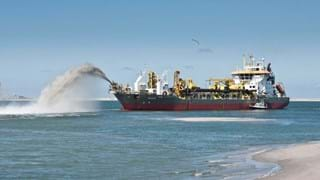The De Ruyter field, discovered in 1996, straddles Blocks P10a and P11b in the North Sea, which are both operated by Petro-Canada. The development consists of a Gravity Base Structure (GBS) with wellhead and lattice towers supporting an Integrated Production Deck (IPD). De Ruyter joins Hanze as Petro-Canada’s second operated offshore field in the Dutch North Sea. Heerema Zwijndrecht was awarded the fabrication, installation and hook-up of the GBS and IPD. The transportation, installation and stabilisation of the GBS was subcontracted to a consortium between Smit Marine Projects and Boskalis Offshore.
Crucial in the design was a proper foundation of the platform, which was complicated by the presence of a silty clay layer a few meters below the seabed, overlying silty sands with silt sublayers. To provide a suitable base on which to position the GBS, sea bed improvements were necessary, which consisted of the removal of 5 meters of material below existing seabed level. After installation the GBS and surrounding soils required further ballasting and stabilisation with rock.

